Regular readers might be aware that before I joined Datalab, I was at the Institute of Physics. And one of our most quoted stats back then – taken from the It’s Different for Girls report – was that 49% of state-funded mixed sex schools send no girls at all on to do A-Level physics.
That report was published more years ago than I care to remember, so I thought it would be interesting to update that statistic, and to take a look at the situation for some other subjects. So in this post, I’ll be looking into the proportion of state-funded mainstream schools that send no pupils on to take A-Levels in the EBacc subjects, and in social sciences and the arts, broken down by gender.
Data
I’ll be using data from the Key Stage 4 pupil table and the Key Stage 5 exam table from the National Pupil Database. I include pupils who completed Key Stage 4 in 2021 in a state-funded mainstream school, and who went on to complete Key Stage 5 in 2023. A school will be deemed to have ‘sent a pupil on’ to study a subject if the pupil completed KS4 in that school in 2021, and then went on to take an A-Level in the subject in 2023 in any institution.
Schools that had thirty or fewer KS4 pupils in 2021 will be excluded. When looking at breakdowns by gender, I include all schools that had at least 30 KS4 pupils of that gender.
Sciences
Seeing as this post was inspired by the Institute of Physics, it seems only fair to start with the sciences. Let’s take a look at the proportion of schools that sent none of their 2021 KS4 pupils on to study science at A-Level in 2023.
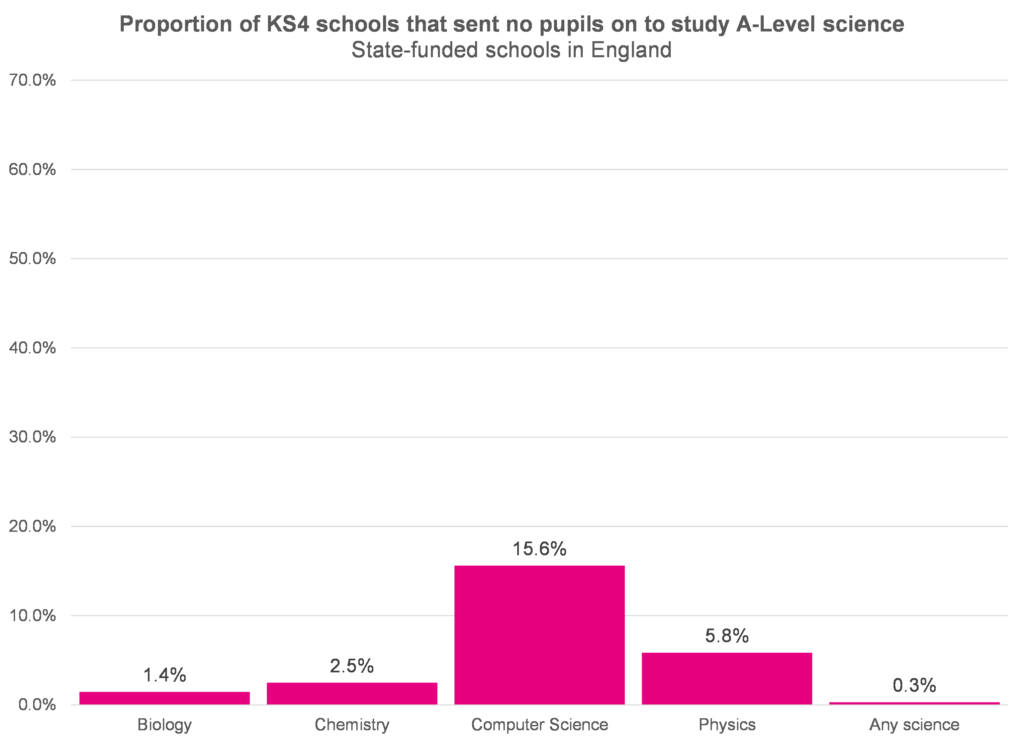
Virtually all schools (99.7%) sent at least one pupil on to study a science subject at A-Level, and the vast majority sent someone on to study biology, chemistry and physics. Schools were rather less likely to send pupils on to study computer science.
Now let’s see how this breaks down by gender.
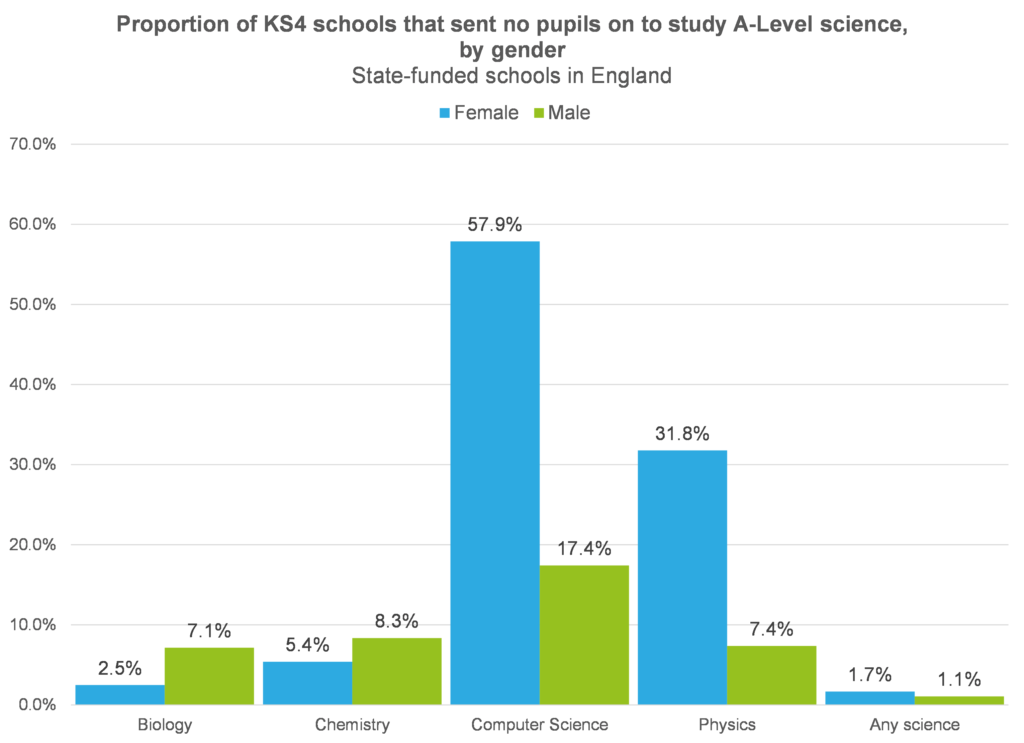
Schools were much more likely to send no girls on to take physics or computer science than to send no boys on. Nearly a third of schools with at least 30 girls at KS4 sent none of them on to A-Level physics, and more than half sent none on to computer science. On the other hand, schools were less likely to send no girls on to biology or chemistry than to send no boys on.
Maths and English
Moving on to take a look at the other group of subjects that are compulsory at Key Stage 4: maths and English.
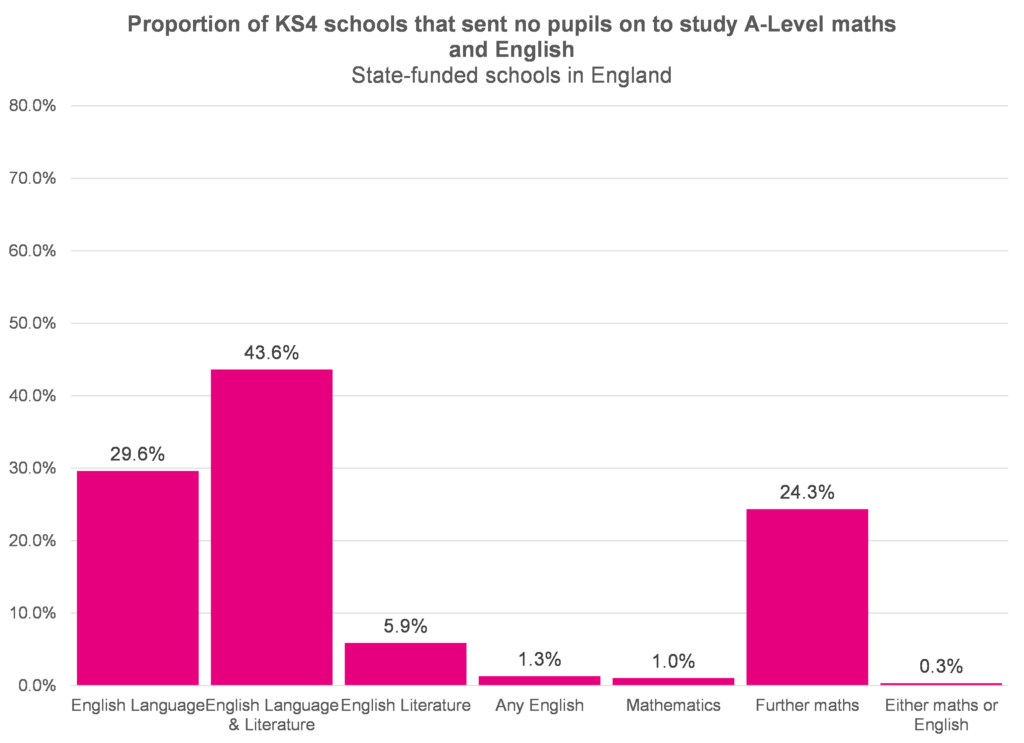
As with science, virtually all schools (99.7%) sent at least one pupil on to study either maths or English at A-Level.[1] Just 1% sent no pupils on to study maths, and 1.3% sent no pupils on to study any type of English A-Level. Of the three English options, schools were far more likely to have sent no pupils on to study language and literature, and less likely to have sent none on to study English literature: this reflects the relative popularity of the subjects nationally.
We also see some interesting differences when we break the data down by gender.
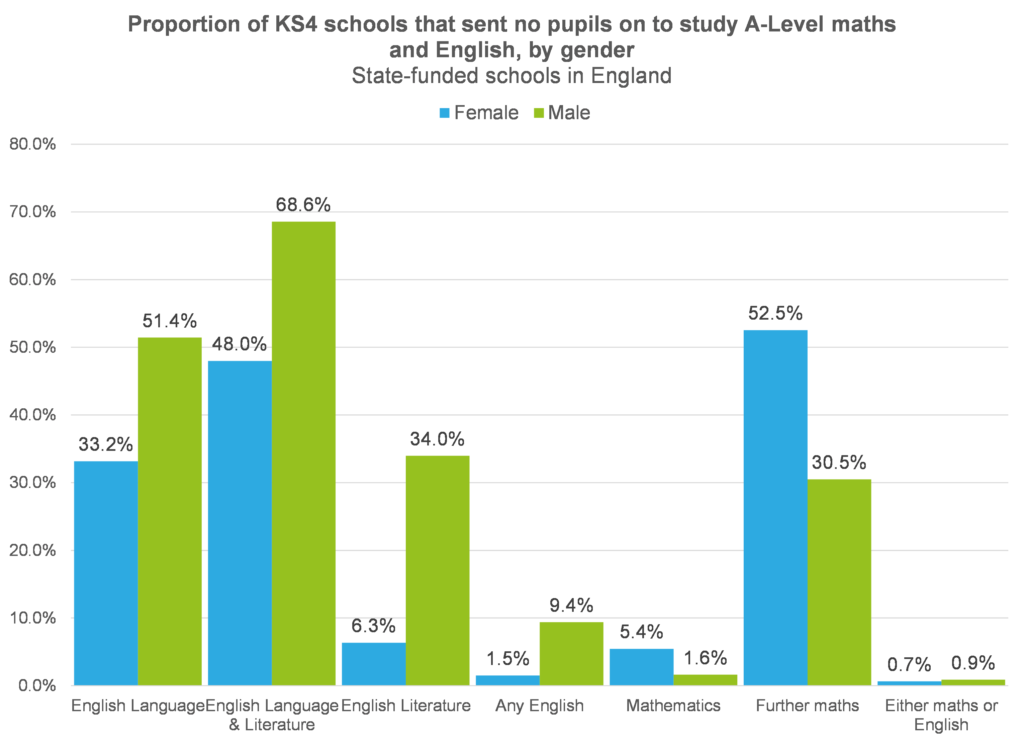
Less than 2% of schools that included at least 30 female pupils sent none of them on to study A-Level English. But nearly one in ten (9.4%) of those with at least 30 male pupils sent none of them on to A-Level English.
We also see a gender difference in maths: 5.4% of schools sent no girls on to A-Level maths, compared to just 1.6% of schools that sent no boys on. And more than half sent no girls on to further maths, compared to less than a third sending no boys on.
Modern foreign languages
Now to languages. And here we see far more schools not sending any pupils on to study modern foreign languages at A-Level than for the other EBacc subjects so far.[2]
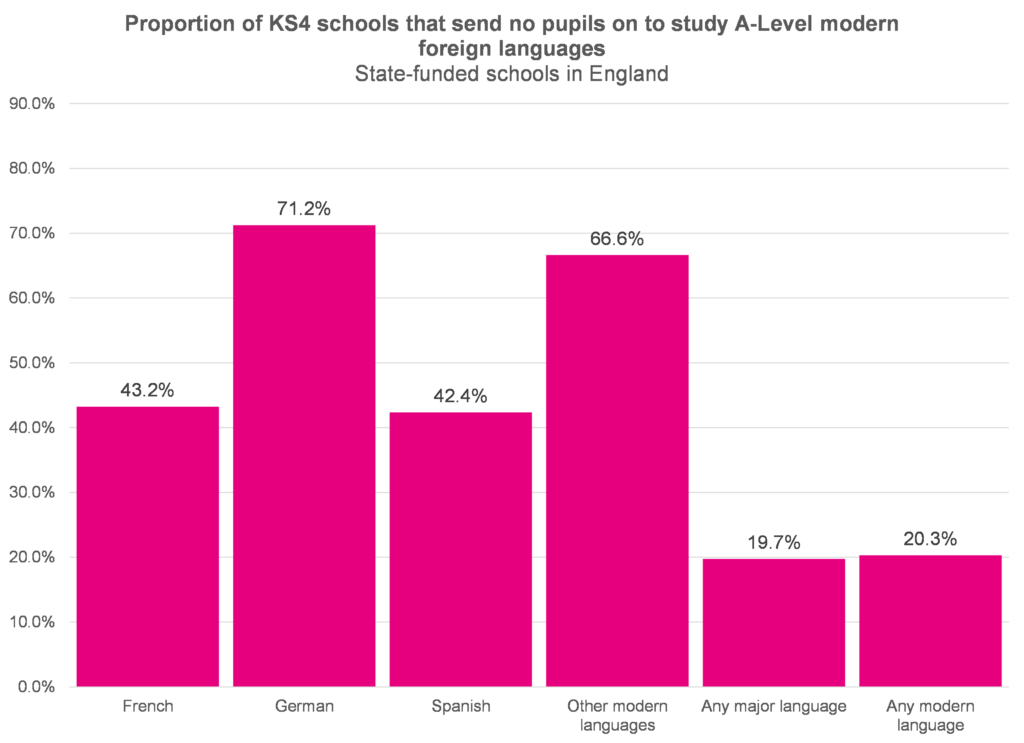
Nearly a fifth (19.7%) of schools sent no pupils on to study an A-Level in one of the three major languages (French, German or Spanish) and just over a fifth sent none on to study any modern foreign language. And we also see some large gender differences.
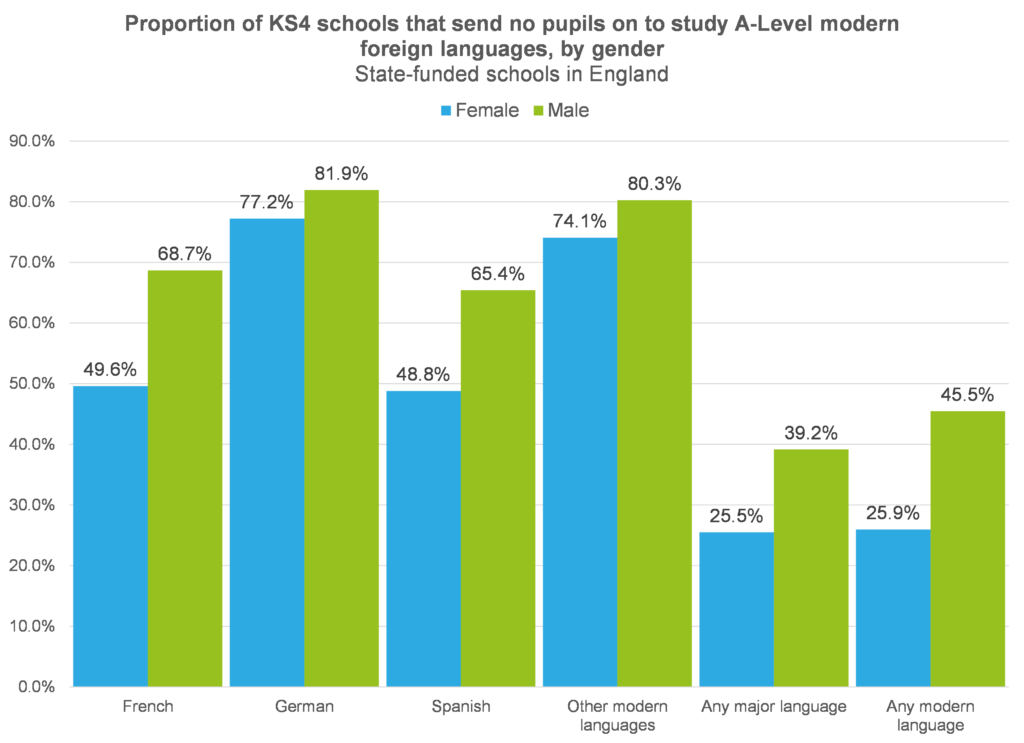
Well over a third (39.2%) of schools with at least 30 male pupils sent none of them on to study an A-Level in one of the three major foreign languages. This compares to just over a quarter (25.5%) of schools with at least thirty female pupils sending none of them on.
And nearly half (45.5%) of schools with at least 30 male pupils sent none of them on to study an A-Level in any modern foreign language, compared to just over a quarter (25.5%) of schools with at least thirty female pupils sending none of them on.
Humanities
And now to the last pillar of the EBacc: humanities. Here again, the vast majority of schools sent at least one pupil on to take a humanities subject at A-Level.

Nearly 99% of schools sent at least one pupil on to study humanities, although it was more common for schools to send no pupils on to geography than none on to history. We do see some differences when we look at the split by gender, although these are less extreme than those we’ve seen in other subjects.
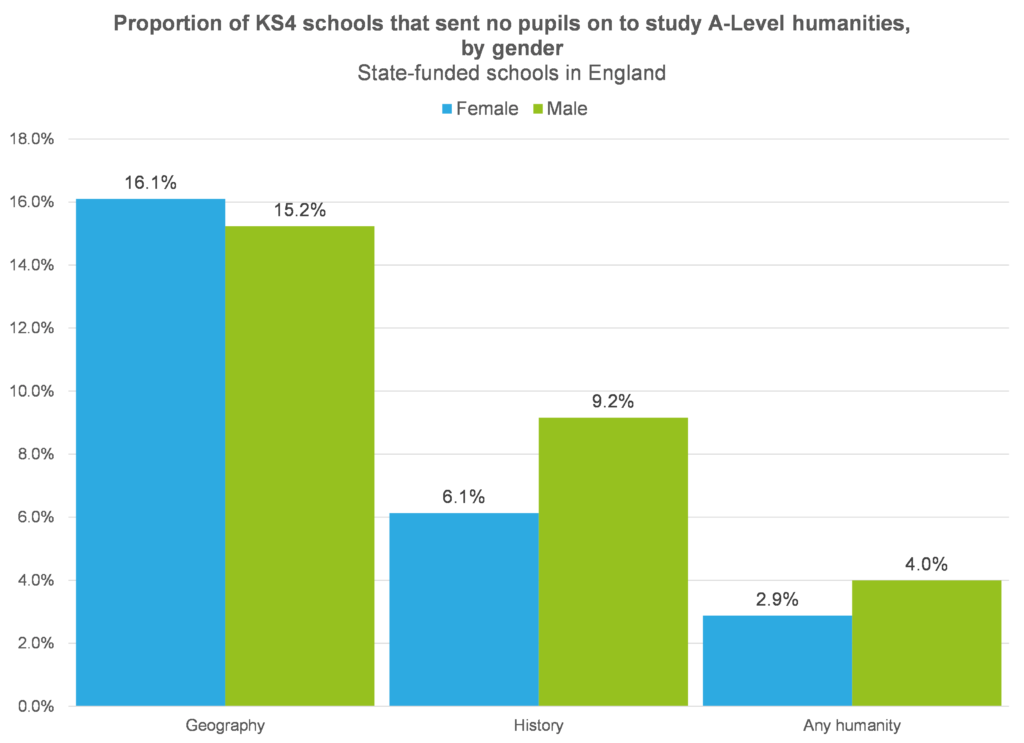
Schools were slightly more likely to send no male pupils on to study humanities than to send no female pupils on, but this is driven by gender differences in progression to history rather than geography.
Social sciences
Now to the social sciences. I’ll be looking at economics, psychology and sociology.
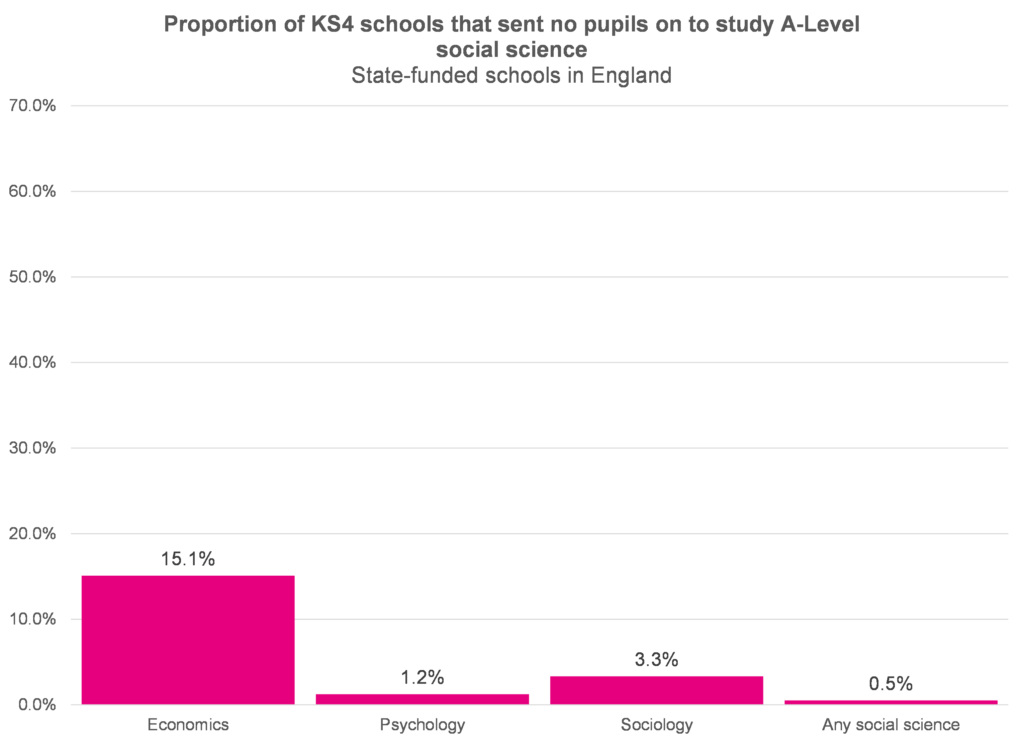
Virtually all schools (99.5%) sent some pupils on to study at least one social science subject. Schools were more likely to send no pupils on to economics than to sociology or especially psychology, reflecting the relative popularity of the subjects.
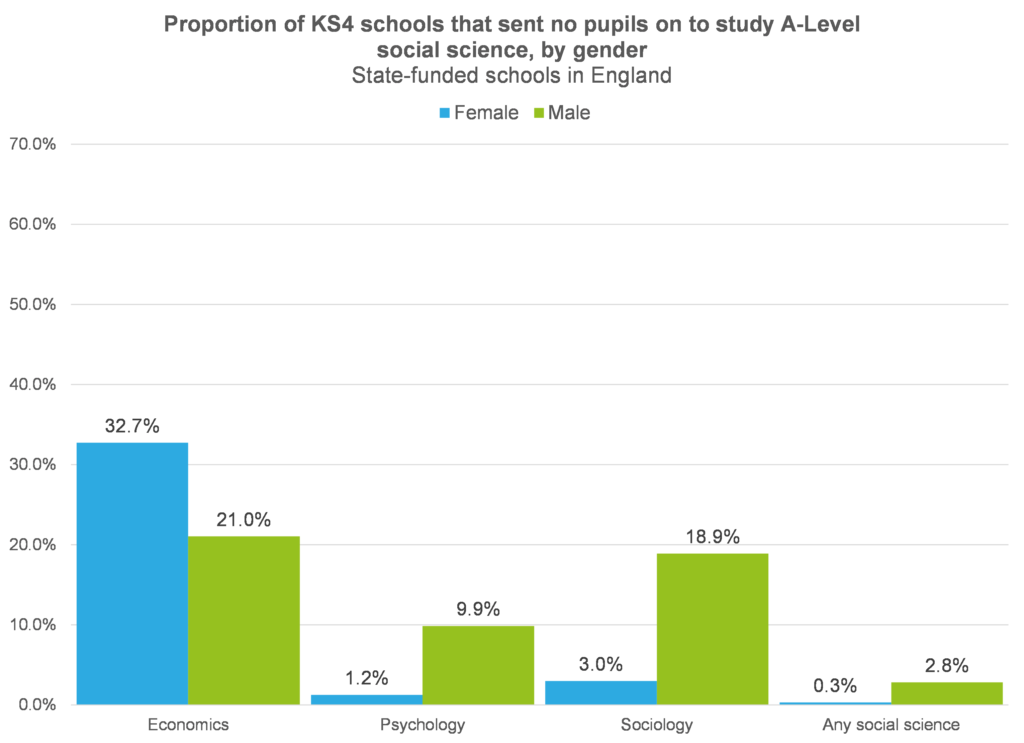
Schools were somewhat less likely to send no female pupils on to study the social sciences than male pupils, but there were large differences between the three subjects. A larger proportion of schools sent no female pupils on to study economics than sent no male pupils on, but the opposite was true of psychology and sociology. Just 1.2% of schools with at least 30 female pupils sent none on to study psychology, while nearly one in ten schools with at least 30 male pupils sent none of them on.
And in sociology, the difference was even starker: just 3% sent no female pupils on, compared to nearly a fifth (18.9%) that sent no boys on.
Arts
And finally, the arts.[4] Here I am including art and design subjects, music, dance, and drama and theatre studies.
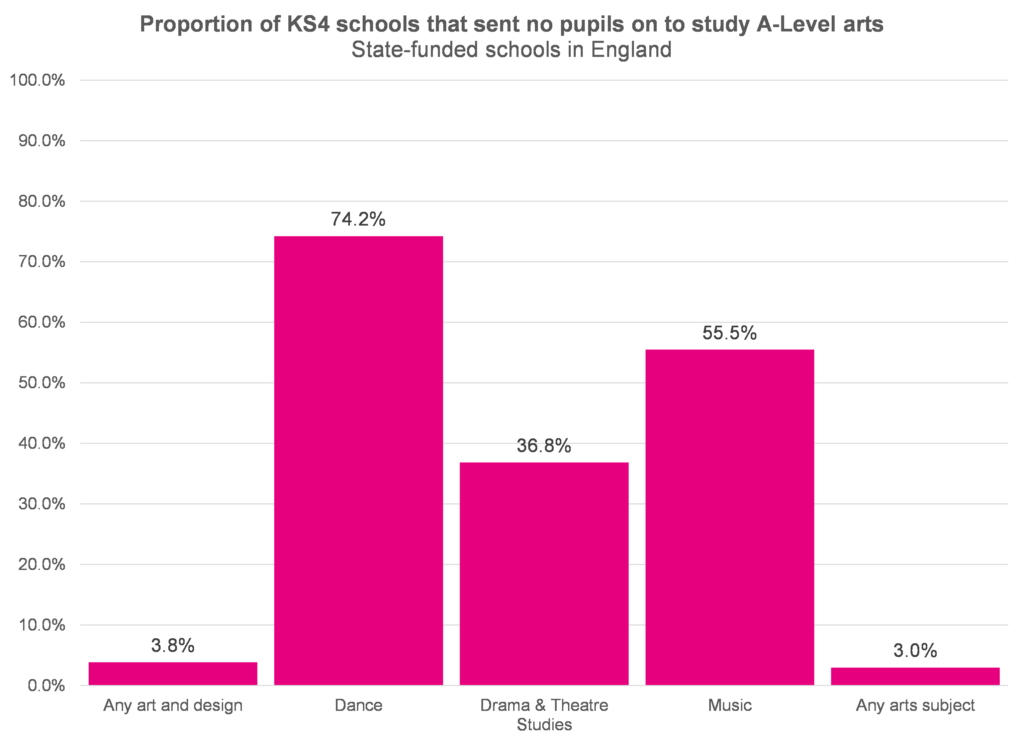
The vast majority of schools (97%) sent at least one pupil on to study either an art and design subject, music, dance or drama. More than half sent no pupils on to study music.
And again, we see some quite stark gender differences.

Just under a fifth of schools with at least 30 male pupils sent none of them on to study art and design, music, dance or drama at A-Level. By comparison, just 3.9% of schools with at least 30 female pupils sent none of them on to study these subjects. But the gender difference was much smaller in music than in art and design, dance and drama.
Summing up
What we’ve seen here reflects the relative popularity of different A-Level subjects and the gender split in entry numbers, much as you might expect. So why is it even worthwhile to look at the number of schools sending no pupils on to A-Levels by subject, rather than just looking at the total numbers studying each subject?
I think the reason is that having no one at all go on to study a subject from a school may become a barrier for potential future students: if choosing that subject is not something that any of your peers have done recently, it may start to feel almost unthinkable for you to do so. And it may indicate a lack of opportunity for pupils from certain schools to pursue certain subjects; some schools or colleges may be unable to offer some subjects due to budgetary constraints, for example.
And I do think it’s worth reflecting, once again, on the stark gender differences in the take-up of A-Level subjects, which will of course reflect different career choices and pathways.
[1]: Mathematics here includes both mathematics and mathematics (statistics).
[2]: Other modern languages includes: Arabic, Bengali, Chinese, Gujarati, Italian, Modern Greek, Modern Hebrew, Persian, Polish, Portuguese, Punjabi, Russian, Turkish, Urdu and Japanese.
Any major language includes: French, Spanish and German.
[3]: Any humanity includes: geography, history, geology and ancient history.
[4]: Any art and design includes: Art & Design, Art & Design (3d Studies), Art & Design (Critical Studies), Art & Design (Fine Art), Art & Design (Graphics), Art & Design (Photography) and Art & Design (Textiles).
Want to stay up-to-date with the latest research from FFT Education Datalab? Sign up to Datalab’s mailing list to get notifications about new blogposts, or to receive the team’s half-termly newsletter.






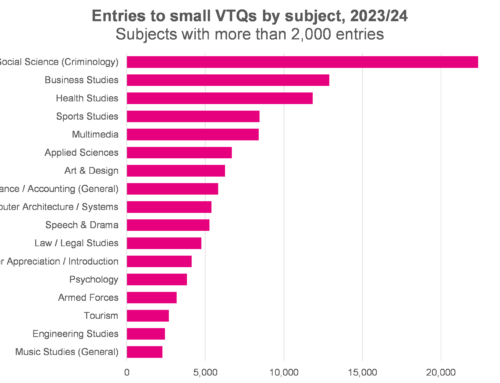
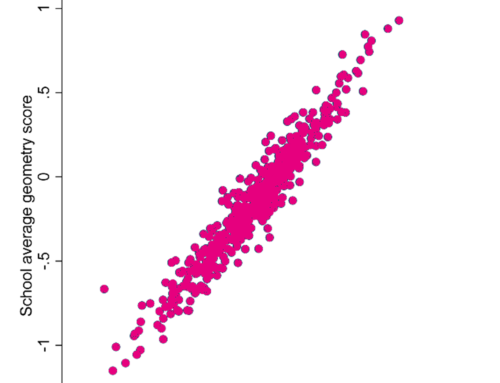

Really interesting data here , thank you for all these insights , it really helps us here look at these trends and reflect upon our data with fresh eyes. One question I’d really be interested for further reflection here – is there any correlation of this data with low disadvantaged or FSM children?
Hi Ciran, thanks for this. I did think about looking at the characteristics of schools that send no pupils on to different subjects, so things like the % of FSM pupils in the school, school type etc, so maybe that’s one for a future post…
Interesting. Can I clarify the base here is all schools where people did KS4 that meet the minimum number criteria? Eg includes special schools, studio schools, etc. My hypothesis would be that those 0.3%s (c. 10 schools?) would be from those unique categories?
Hi Ben, I included all *mainstream* schools that met the minimum number criteria – so I excluded special schools and AP. I suspect a few of them are not much over the 30 pupil threshold, and some might be studio schools.
This data is so interesting.
I am a Geotechnical Engineer and when I worked as a Site Agent in 2017, was 1%. This has now risen to a whopping 2%. [1]
I now work for a local authority and am a loyal STEM Ambassador. I will be starting a project in 2025 which will help raise the profile of STEM subjects, resources and STEM Ambassadors to schools linked to the Local Authority in Bromley, to hopefully shape the local authorities role in sharing information for others to follow. If you would be interested in how this project progresses, then please contact me.
Thanks Helayna, and the project sounds great – raising the profile of STEM is an aim close to my heart, hope all goes well!